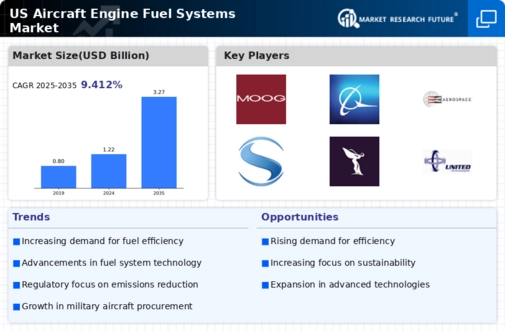The aircraft engine fuel systems market is characterized by a competitive landscape that is increasingly shaped by technological advancements and strategic collaborations. Key players such as General Electric (US), Honeywell International (US), and Pratt & Whitney (US) are at the forefront, leveraging innovation and operational efficiencies to enhance their market positions. General Electric (US) focuses on integrating advanced digital technologies into its fuel systems, aiming to improve performance and reduce emissions. Meanwhile, Honeywell International (US) emphasizes sustainability, developing fuel systems that align with the growing demand for eco-friendly aviation solutions. Pratt & Whitney (US) is also investing in next-generation fuel systems, which are designed to optimize fuel efficiency and reduce operational costs, thereby collectively influencing the competitive dynamics of the market.
The business tactics employed by these companies reflect a concerted effort to localize manufacturing and optimize supply chains. The market structure appears moderately fragmented, with several players vying for market share while also collaborating on various projects. This competitive environment is further influenced by the strategic initiatives of major companies, which often involve partnerships and joint ventures aimed at enhancing technological capabilities and expanding market reach.
In November 2025, General Electric (US) announced a partnership with a leading aerospace manufacturer to develop a new line of fuel-efficient engines. This collaboration is expected to leverage GE's expertise in fuel systems and the partner's manufacturing capabilities, potentially leading to significant advancements in engine performance and sustainability. Such strategic moves indicate a shift towards collaborative innovation in the market.
In October 2025, Honeywell International (US) launched a new fuel management system that utilizes AI to optimize fuel consumption in real-time. This system is designed to provide airlines with actionable insights, thereby enhancing operational efficiency and reducing costs. The introduction of AI-driven solutions reflects a broader trend towards digital transformation within the industry, positioning Honeywell as a leader in this domain.
In September 2025, Pratt & Whitney (US) unveiled a new fuel system that incorporates advanced materials to withstand higher temperatures and pressures. This innovation is likely to enhance the durability and efficiency of aircraft engines, aligning with the industry's push for more robust and reliable fuel systems. Such advancements not only improve performance but also contribute to the overall sustainability goals of the aviation sector.
As of December 2025, the competitive trends in the aircraft engine fuel systems market are increasingly defined by digitalization, sustainability, and the integration of AI technologies. Strategic alliances are becoming more prevalent, as companies recognize the need to collaborate in order to stay competitive. The focus appears to be shifting from price-based competition to differentiation through innovation and technological advancements. This evolution suggests that future competitive dynamics will hinge on the ability to deliver reliable supply chains and cutting-edge solutions that meet the demands of a rapidly changing market.






















Leave a Comment